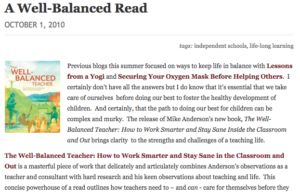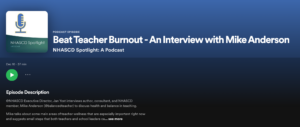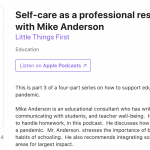A Well-Balanced Read – Wonder of Children
Original Article: https://wonderofchildren.wordpress.com/2010/10/01/a-well-balanced-read/
[custom_frame_right]# [/custom_frame_right] Previous blogs this summer focused on ways to keep life in balance with Lessons from a Yogi and Securing Your Oxygen Mask Before Helping Others. I certainly don’t have all the answers but I do know that it’s essential that we take care of ourselves before doing our best to foster the healthy development of children. And certainly, that the path to doing our best for children can be complex and murky. The release of Mike Anderson’s new book, The Well-Balanced Teacher: How to Work Smarter and Stay Sane Inside the Classroom and Out brings clarity to the strengths and challenges of a teaching life.
[/custom_frame_right] Previous blogs this summer focused on ways to keep life in balance with Lessons from a Yogi and Securing Your Oxygen Mask Before Helping Others. I certainly don’t have all the answers but I do know that it’s essential that we take care of ourselves before doing our best to foster the healthy development of children. And certainly, that the path to doing our best for children can be complex and murky. The release of Mike Anderson’s new book, The Well-Balanced Teacher: How to Work Smarter and Stay Sane Inside the Classroom and Out brings clarity to the strengths and challenges of a teaching life.
The Well-Balanced Teacher: How to Work Smarter and Stay Sane in the Classroom and Out is a masterful piece of work that delicately and articulately combines Anderson’s observations as a teacher and consultant with hard research and his keen observations about teaching and life. This concise powerhouse of a read outlines how teachers need to – and can – care for themselves before they can give their best to students and schools. Seems like a pretty simple message, but if you know many teachers, you know that message often gets put on the back burner. Much like Daniel Pink asserts in his book, Drive, Anderson aligns the key to high performance in the classroom to the basic human need to feel a genuine sense of belonging and significance along with a balance of autonomy and connectedness which allows us to feel our work has meaning.
The Well-Balanced Teacher goes beyond citing what we already know about meeting basic needs (sleep, food, water) and feeling significant in our community and competent in our craft. Many of the points Anderson makes are ones we know in our heart, but the reminders are appreciated. He goes on to provide cogent tactics and strategies to work more efficiently. Some are pretty basic, yet functional (reworking your personal schedule to reflect a reasonable allocation of your resources) while others might be a paradigm shift (re-writing your goals to reflect observable data and respond to questions that arise to generate actionable goals).
Anderson’s voice as a thoughtful, experienced and empathetic colleague rings strong throughout the book. He acknowledges most teachers are perfectionists who tend to deflect compliments, put in long hours, and desire to give each and every child their best. He affirms these qualities but gently gives teachers permission to let go, relax and enjoy the ride without feeling that they’ve short-changed anyone or anything. By clarifying your goals, affirming your strengths as a teacher and interests as a human, Anderson nudges teachers to be more proactive in asserting their needs (whether it’s to honor planning time or family time) while also being realistic about your obligations to teach the curriculum and know your students.
Teaching is a stressful career with multiple layers of demands added regularly. Nobody can do it all, certainly not if sustaining a rich teaching and personal life is paramount. Anderson asserts that if we first accept that there is in fact a time crunch, we can forge ahead to determine what is nonnegotiable, peel off what is not essential (often by saying “no” or asking or support), and then streamline schedules and demands to work more efficiently.
Knowing that you’ve got a lot on your plate, Anderson’s book is roughly 100 pages of concentrated observations and recommendations – simple, practical, responsive, actionable. Check it out onFacebook or on ASCD’s site and see what helps you be a more well-balanced teacher yourself.




